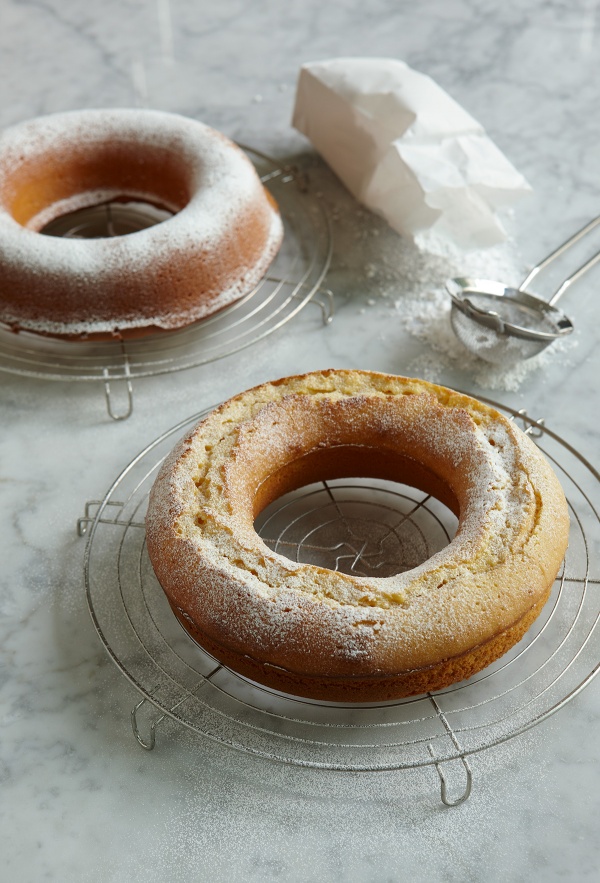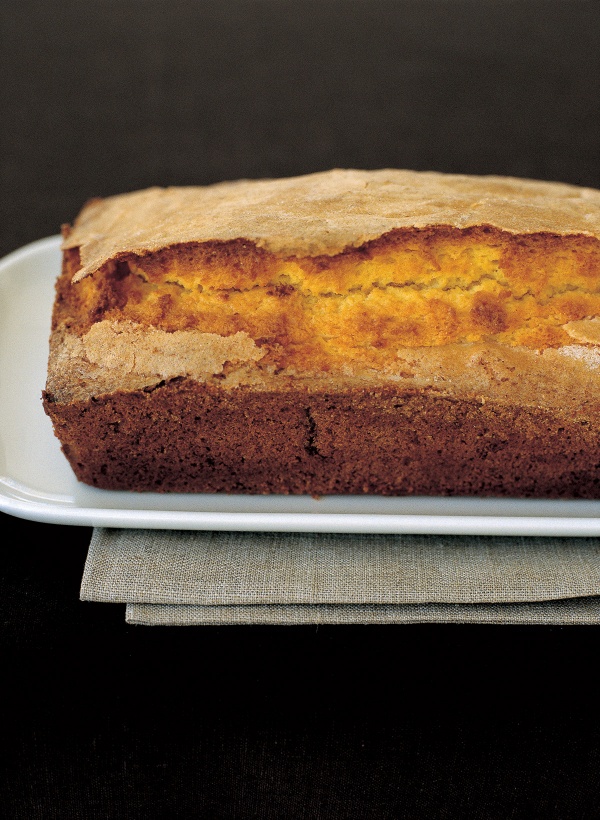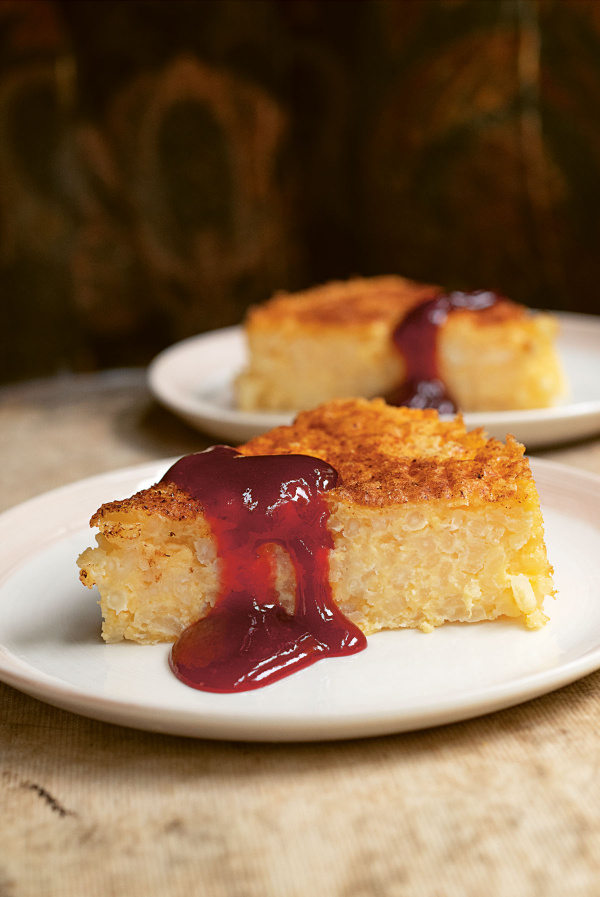Yogurt Pot Cake
by Nigella. Featured in NIGELLISSIMAIntroduction
If there’s a family in Italy that doesn’t have a recipe for yogurt pot cake, then I’ve yet to meet them. And I love this plain cake with perhaps disproportionate intensity. There is something so quintessentially Italian about its scent — as it bakes, I think I’m in a kitchen in Italy — and its taste — that combination of lemon and vanilla — and even the old-fashioned charm of its method.
This is it: your yogurt pot is your unit of measurement. And even though I saw from the original recipe that I copied down (from some scrawled piece of paper in the kitchen of a house I’d rented one summer), that the specified yogurt pot had a 125ml capacity, I have kept the same number of eggs for my 150ml yogurt pot. I work on the principle that eggs these days are larger than when the cake first came into being. Anyway, it works, and that’s the main thing. And this is the way it works: for 1 cake, you need 1 pot of yogurt, 2 pots of sugar, 1 pot of oil, 1 pot of potato starch or cornflour and 2 pots of flour. In keeping with this style of measuring, you will see that I have even stipulated 2 capfuls of vanilla extract.
If there’s a family in Italy that doesn’t have a recipe for yogurt pot cake, then I’ve yet to meet them. And I love this plain cake with perhaps disproportionate intensity. There is something so quintessentially Italian about its scent — as it bakes, I think I’m in a kitchen in Italy — and its taste — that combination of lemon and vanilla — and even the old-fashioned charm of its method.
This is it: your yogurt pot is your unit of measurement. And even though I saw from the original recipe that I copied down (from some scrawled piece of paper in the kitchen of a house I’d rented one summer), that the specified yogurt pot had a 125ml capacity, I have kept the same number of eggs for my 150ml yogurt pot. I work on the principle that eggs these days are larger than when the cake first came into being. Anyway, it works, and that’s the main thing. And this is the way it works: for 1 cake, you need 1 pot of yogurt, 2 pots of sugar, 1 pot of oil, 1 pot of potato starch or cornflour and 2 pots of flour. In keeping with this style of measuring, you will see that I have even stipulated 2 capfuls of vanilla extract.

Share or save this
Ingredients
Yields: 16 slices
- 150 grams plain yoghurt
- 150 millilitres vegetable oil (plus some for greasing)
- 3 large eggs
- 250 grams caster sugar
- 1½ teaspoons vanilla extract
- zest of ½ unwaxed lemon
- 175 grams plain flour
- 75 grams cornflour
- 1 teaspoon icing sugar (to serve)
- ⅔ cup plain yogurt
- ⅔ cup vegetable oil (plus some for greasing)
- 3 large eggs
- 1¼ cups granulated sugar
- 1½ teaspoons vanilla extract
- zest of ½ unwaxed lemon
- 1⅓ cups all-purpose flour
- ⅔ cup cornstarch
- 1 teaspoon confectioners' sugar (to serve)
Method
I know this cake best in a ring shape, ciambella (pronounced “chambella”) as it’s known in Italy, and a 22cm/9-inch savarin or ring mould is a fairly standard baking tin here in the UK, too, but do use a 22 or 23cm/9-inch springform tin if that’s easier for you: the cake won’t be as high, but don’t use a smaller diameter because, without the hole in the middle, the cake wouldn’t cook properly in the centre if the tin were any deeper.
- Preheat the oven to 180°C/160°C Fan/gas mark 4/350°F, and grease your ring mould (or springform tin); you can use vegetable oil for this or a special baking spray.
- Separate the eggs and put the whites in one bowl and the yolks in another. Whisk the whites until you have firm peaks, then set aside while you get on with the rest of the cake.
- Scrape the yogurt out of its pot and on to the egg yolks, then use the emptied yogurt pot to measure out your other ingredients — so, next, add 2 pots (just) of sugar and whisk with the egg yolks and yogurt until airy and light.
- Now fill your yogurt pot up with vegetable oil and, beating all the while, slowly add this to the egg yolk mixture. Then beat in 2 capfuls/teaspoons of vanilla extract and the zest of half a lemon.
- Still beating, add 2 yogurt potfuls of flour followed by 1 yogurt potful of cornflour or potato starch, then scrape down and fold in with a rubber or silicone spatula. Now, with a large metal spoon, dollop in the whisked egg whites, and fold them in with the spatula.
- Fill the prepared ring mould with the smooth, soft batter — it will come right to the top — and bake in the oven for 30–35 minutes; when cooked, the sides will be coming away at the edges and a cake tester will come out clean.
- Remove it from the oven to a wire rack, letting the cake sit in the tin for 10 minutes before turning it out.
- Once cooled (although I love this still slightly warm), transfer it to a serving plate or stand and dust with icing sugar. Traditionally, this cake would be placed on the plate with the smooth side uppermost, but I rather like it turned back up the way it was baked, with its rustic cracks and uneven surface visible.
I know this cake best in a ring shape, ciambella (pronounced “chambella”) as it’s known in Italy, and a 22cm/9-inch savarin or ring mould is a fairly standard baking tin here in the UK, too, but do use a 22 or 23cm/9-inch springform tin if that’s easier for you: the cake won’t be as high, but don’t use a smaller diameter because, without the hole in the middle, the cake wouldn’t cook properly in the centre if the tin were any deeper.
- Preheat the oven to 180°C/160°C Fan/gas mark 4/350°F, and grease your ring mould (or springform tin); you can use vegetable oil for this or a special baking spray.
- Separate the eggs and put the whites in one bowl and the yolks in another. Whisk the whites until you have firm peaks, then set aside while you get on with the rest of the cake.
- Scrape the yogurt out of its pot and on to the egg yolks, then use the emptied yogurt pot to measure out your other ingredients — so, next, add 2 pots (just) of sugar and whisk with the egg yolks and yogurt until airy and light.
- Now fill your yogurt pot up with vegetable oil and, beating all the while, slowly add this to the egg yolk mixture. Then beat in 2 capfuls/teaspoons of vanilla extract and the zest of half a lemon.
- Still beating, add 2 yogurt potfuls of flour followed by 1 yogurt potful of cornstarch or potato starch, then scrape down and fold in with a rubber or silicone spatula. Now, with a large metal spoon, dollop in the whisked egg whites, and fold them in with the spatula.
- Fill the prepared ring mould with the smooth, soft batter — it will come right to the top — and bake in the oven for 30–35 minutes; when cooked, the sides will be coming away at the edges and a cake tester will come out clean.
- Remove it from the oven to a wire rack, letting the cake sit in the tin for 10 minutes before turning it out.
- Once cooled (although I love this still slightly warm), transfer it to a serving plate or stand and dust with confectioners' sugar. Traditionally, this cake would be placed on the plate with the smooth side uppermost, but I rather like it turned back up the way it was baked, with its rustic cracks and uneven surface visible.
Additional Information
MAKE AHEAD:
Can be made ahead - store in an airtight container in a cool place for 2-3 days or freeze for up to 3 months, wrapped in a double layer of clingfilm, followed by a layer of foil. Unwrap and defrost at room temperature for about 2 hours.
MAKE AHEAD:
Can be made ahead - store in an airtight container in a cool place for 2-3 days or freeze for up to 3 months, wrapped in a double layer of clingfilm, followed by a layer of foil. Unwrap and defrost at room temperature for about 2 hours.






Tell us what you think
Thank you {% member.data['first-name'] %}.
Explore more recipesYour comment has been submitted.
What 20 Others have said
-
Posted by JanaInanc on 28th October 2021
-
Posted by MrsCsansgluten on 24th October 2021
-
Posted by Mel22_ on 8th June 2021
-
Posted by jillbell on 8th May 2021
-
Posted by Era17 on 5th May 2021
-
Posted by 194840 on 19th May 2020
-
Posted by pkrcj29 on 14th May 2020
-
Posted by jvallas on 30th January 2019
-
Posted by Heather Cooks on 11th June 2018
-
Posted by Purple Pear on 31st May 2018
-
Posted by sharon57 on 30th May 2018
-
Posted by Valpat on 30th May 2018
Show more commentsI love making this cake with couple of small changes. Orange zest instead of lemon, extra juice of 1 orange and 2 handfuls of chocolate chips. My kids absolutely adore it!
A great recipe and easily adapted for gluten free. Made in greased and floured silicone doughnut moulds rather than a Bundt tin. Worked really well.
I made this in Bundt tin, came about halfway up, still good sized cake. Cornflour makes lovely light texture. I used the weights set out in recipe as only had large tub of yogurt, also used 50g less sugar and was delicious. Lemon flavour just right. Baked at 160C in fan oven and was cooked perfectly in 30 minutes. Will make again.
I think I have gone to heaven. Made this using double cream honey blossom yoghurt. It is incredible. Thank you Nigella
One of my favourite quick cakes! So simple to make and it's so tasty & fluffy. Perfect with a cuppa Joe!
Have just made this cake. Who would have thought something so simple would be so good. Thank you
Just baked using gluten free plain flour in a Bundt tin, came out of tin perfectly, tastes yummy. Thank you for all the great recipie ideas.
About the tin - while searching to buy one, I discovered: 1) you can use a regular cake pan with a wide glass (or large empty tomato can) in the center, or 2) if you’re not having luck with the term “Ciambella,” try savarin mold, monkey bread pan, pan with funnel (le creuset has an expensive one). I also had good luck searching for “coffee cake pan.”
Just made this and it looks delicious - have to wait for tomorrow to taste - taking it to work !
It’s delicious made with absolutely any yoghurt, flavoured or plain. My recipe is from South Africa - it was a popular bake in the 1970’s - and the yoghurt pots of the day were 175ml. Proportionally all measures, to the yoghurt pot, are the same as above also the 3 eggs. Lovely to see this recipe making a come back.
We also use this recipe in Spain,most cake recipes here use cup,or in this case yoghurt pots,rather than weight for their cake making, took me a while to get used to this idea but after forty years I'm now a convert.
Lovely cake. Went down very well at Tennis Club teas.